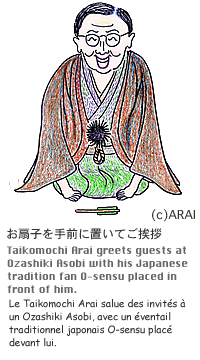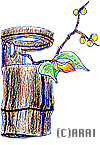|
.
|
 In
the transitional period from the last days of the Tokugawa
Shogunate (1603-1867), which had adopted the policy of
national seclusion from the rest of the world, to Meiji
Restoration with introduction of Western civilization for
the political transition from military to civilian,
Taikomochi were allegedly enjoying flourishing popularity
with their number having reached 500 to 600 at its peak.
Thereafter, the number of Taikomochi continued to decline,
especially after the end of the World War II with
Japan’s surrender under the Occupation authorities,
which ordered the abolition of licensed brothels in 1946,
followed by the enactment of the Prostitution Prevention Law
in 1958, causing licensed prostitution to be completely
abolished for prohibition of Yujo and brothels. This, in
turn, adversely affected the traditional Geisha
entertainment culture, causing it to be driven into a
corner, although the fact of the matter was that the
situation in those days did not permit any one to enjoy such
culture economically. In
the transitional period from the last days of the Tokugawa
Shogunate (1603-1867), which had adopted the policy of
national seclusion from the rest of the world, to Meiji
Restoration with introduction of Western civilization for
the political transition from military to civilian,
Taikomochi were allegedly enjoying flourishing popularity
with their number having reached 500 to 600 at its peak.
Thereafter, the number of Taikomochi continued to decline,
especially after the end of the World War II with
Japan’s surrender under the Occupation authorities,
which ordered the abolition of licensed brothels in 1946,
followed by the enactment of the Prostitution Prevention Law
in 1958, causing licensed prostitution to be completely
abolished for prohibition of Yujo and brothels. This, in
turn, adversely affected the traditional Geisha
entertainment culture, causing it to be driven into a
corner, although the fact of the matter was that the
situation in those days did not permit any one to enjoy such
culture economically.
 After
the war, Japan underwent various other reforms including a
tax reform with resultant disappearance of wealthy lords,
paving the way for the nation’s economic expansion in
the 1960s in which the average people’s living
conditions began to improve, all of them having middle-class
consciousness, to create society where every one was
entitled to equal access to opportunity for entertainment.
Around 1977, there was a boom in karaoke (prerecorded music
tape to which one can sing as his or her leisure activity),
which found its way into the Japanese traditional
entertainment business with resultant sharp reduction in
demand for geisha at banquets as a result of their
replacement with their contemporary counterparts called
“companions” (young women dressed in western style
clothes, not kimono, entertaining guests as their
conversational partners while serving them sake). The same
was true for Taikomochi with their number thereafter reduced
at such a high rate that they now number only five (5) (four
in Tokyo and myself) as valuable performing artists capable
of handing down the traditional geisha entertainment culture
to the following generations. As one of the few, I, with my
principal place of business in the vicinity of Kyoto, the
birthplace of Japan’s culture, have determined to take
over the tradition of Otogishu or Hanashishu to transmit the
Japan’s history and culture to my clients through my
traditional erotic, but sophisticated storytelling and
performing art. After
the war, Japan underwent various other reforms including a
tax reform with resultant disappearance of wealthy lords,
paving the way for the nation’s economic expansion in
the 1960s in which the average people’s living
conditions began to improve, all of them having middle-class
consciousness, to create society where every one was
entitled to equal access to opportunity for entertainment.
Around 1977, there was a boom in karaoke (prerecorded music
tape to which one can sing as his or her leisure activity),
which found its way into the Japanese traditional
entertainment business with resultant sharp reduction in
demand for geisha at banquets as a result of their
replacement with their contemporary counterparts called
“companions” (young women dressed in western style
clothes, not kimono, entertaining guests as their
conversational partners while serving them sake). The same
was true for Taikomochi with their number thereafter reduced
at such a high rate that they now number only five (5) (four
in Tokyo and myself) as valuable performing artists capable
of handing down the traditional geisha entertainment culture
to the following generations. As one of the few, I, with my
principal place of business in the vicinity of Kyoto, the
birthplace of Japan’s culture, have determined to take
over the tradition of Otogishu or Hanashishu to transmit the
Japan’s history and culture to my clients through my
traditional erotic, but sophisticated storytelling and
performing art.
|
.
|
![]()